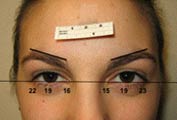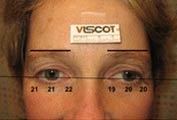Dr. Yaremchuk:
Thoughts and Data on the Shape and Position of Women’s Brows in Youth and Age
Several articles in the plastic surgery literature conclude that many brow lifts produce eyebrows with shape and position which are not aesthetically pleasing. We compared eyebrow shape and position in both young and mature women to provide objective data to plan forehead rejuvenating procedures.
Two groups of women ages 20-30 and 50-60 were photographed to determine eyebrow position. Measurements were made from a horizontal plane between the medial canthi to three points at the upper eyebrow margin
Lateral brow position was significantly higher than the mid-brow in the young group. The brow was higher in older compared to younger subjects at all three points. This difference was significant at the medial and mid-brow (p<.05).
Unlike other areas of the body where there is descent of soft tissues, there is paradoxical elevation of eyebrows with aging in a certain proportion of patients. These findings explain why surgical elevation of the mid and medial brow provides results that are neither youthful nor aesthetically pleasing. This explains why many patients are displeased with the shape and position of their brows after certain browlift procedures and seek reversal of their browlift.
Techniques that selectively elevate the lateral brow are more likely to have a rejuvenating effect on the upper third of the female face.
Brow Shape Changes from |
|
| 20 years old (patients = 18) |
50 years old (patients = 17) |
 |
 |
| apex lateral | apex neutral |
Legend: Typical results for patients from each cohort are shown. Younger patients have a medial brow which is low, with the apex of the brow positioned lateral . Older patients have an elevated medial and middle brow which contributes to a flattened or apex neutral appearance. Measurements to the top of the brow margin are shown for each point measured.
